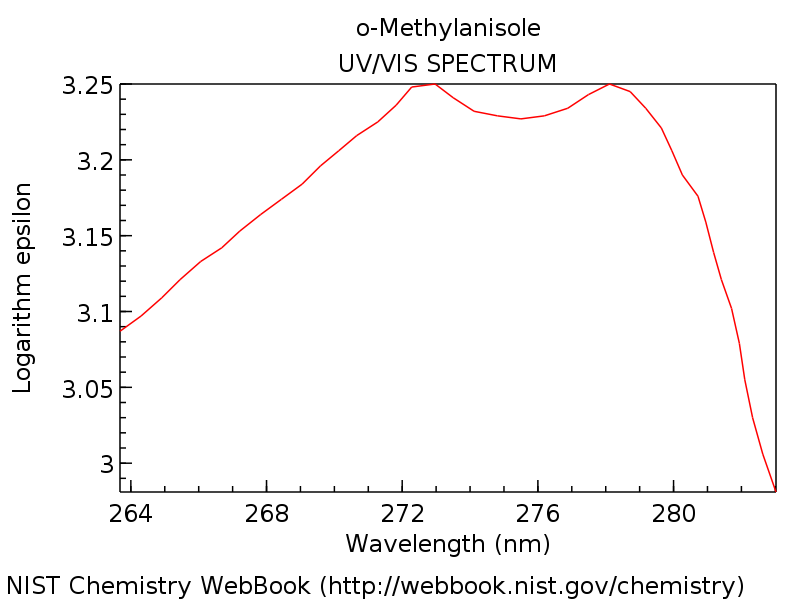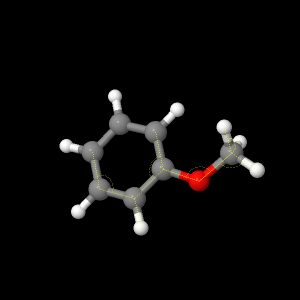Once the molecule file is fully loaded, the image at right will become live. At that time the "activate 3-D" icon ![]() will disappear.
will disappear.
Anisole
Using MacMol*, five different levels of optimization were
compared: AM1, PM3, 6-21G, 6-31G, and DZV. It was found that the
DZV optimization gave the minimum energy making it the most
energetically favorable orientation. The literature values for
bond lengths is C=C: 1.3 angstroms, Csp2-H: 1.08 angstroms, Csp3-H: 1.09 angstroms, and C-
O: 1.34 angstroms. The literature values for bond angles is H-C-Cring: 120 degrees, C-C-C: 120.5 degrees, C-O-C: 109.5 degrees and H-C-H: 109.5 degrees.1
O: 1.34 angstroms. The literature values for bond angles is H-C-Cring: 120 degrees, C-C-C: 120.5 degrees, C-O-C: 109.5 degrees and H-C-H: 109.5 degrees.1
The optimization AM1 was further optimized using the 6-21G. The 6-21G optimization is the lowest level of optimization found in the ab initio.
The 6-21G was further optimized using the 6-31G.
The 6-31G was further optimized using the DZV. The DZV is the highest level of optimization in the ab initio.
The HOMO is the highest occupied molecular orbital. This orbital is calculated by adding the electrons in each atom and then dividing by two. In the case of anisole, there are 52 electrons, so the HOMO orbital is the 26th orbital.
The LUMO is the lowest unoccupied molecular orbital. This orbital is found by moving up to the next highest orbital from the HOMO. In this case, it was the 27th orbital. No electrons are normally here, however the electrons can be excited to the LUMO orbital.
The electrostatic potential is a representation of the electric potential energy as it varies throughout the molecule. In the image, the red area represents a higher density of the electrons and thus a higher electric potential energy. The blue area represents a lower density of electrons and thus a lower electric potential energy. Since oxygen is more electronegative than the carbons it is bonded to, the electrons are in closer proximity to the oxygen than the carbons resulting in more electron density which is seen by the red. Since there is conjugation in the benzene ring, electrons are free to move from p orbital to p orbital. The average of the overlap causes electron density which is why red is seen in the middle of the benzene ring.
Because of the similarity in electronegativity of carbon and hydrogen, there are very small partial charges on these atoms. Oxygen has a large electronegativity compared to carbon, so it results in a large negative partial charge creating a partial positive charge on the neighboring carbon. The oxygen pulls electrons from the ring, so as seen, the partial charges increase the further away from oxygen the atoms get.
The vibrational frequency for the Csp3-O stretch was found to be 1122.24 cm^-1.
The vibrational frequency for the Csp2-O stretch was found to be 839.8 cm^-1.
The vibrational frequency for the C=C stretch was found to be 1775.09 cm^-1.
The vibrational frequency for the Csp2-H stretch was found to be 3439.26 cm^-1.
The vibrational frequency for the Csp3-H stretch was found to be 3226.35 cm^-1.
The vibrational frequency for the C-H vibration was found to be 1657.15 cm^-1.
The vibrational frequency for the C-C vibration was found to be 1796.21 cm^-1.

Figure 1: IR spectrum of anisole.1
The above vibrational frequencies for the stretching and vibrations correspond to the peaks found in the anisole IR spectrum.

Figure 2: UV-Vis spectrum of Anisole.1
Table 3: UV-Vis Absorption Peak Positions
| Transition From Ground to Excited State # |
Wavelength (nm) |
| 1 |
198 |
| 2 |
189 |
| 3 |
148 |
| 4 |
145 |
| 5 |
134 |
| 6 |
129 |
| 7 |
127 |
| 8 |
123 |
| 9 |
120 |
| 10 |
119 |
The expected UV-Vis absorption peaks are found at larger wavelengths and thus lower energies than the experimental peaks which had smaller wavelengths and higher energies.
Since the molecule anisole contains an electronegative element, it is clear there will be a dipole moment that will occur. The literature value found for the dipole moment is 1.199 Debye.3 The calculated dipole is 1.274 This give an error of 6.26%.
You may look at any of these intermediate views again by clicking on the appropriate button.
Page skeleton and JavaScript generated by export to web function using Jmol 14.2.12_2015.01.22 2015-01-22 21:48 on Mar 7, 2015.
This will be the viewer


If your browser/OS combination is Java capable, you will get snappier performance if you use Java